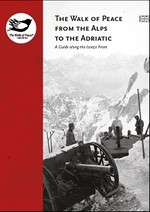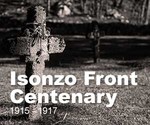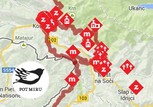The Battle of Caporetto ─ The Twelfth Battle of Isonzo (24–28 October 1917)
 |
The defenders of the Isonzo Front were aware they would not be able to hold back another Italian attack. They asked their German allies for help, the preparations for a joint Austian-Hungarian-German offensive commenced during the 11th Battle of the Isonzo. The new offensive was called Waffentreue (“loyalty in arms”) and was planned by the German General Kraft von Dellmensingen. The 1st and 2nd Isonzo Armies, which were already positioned along the river, were joined by twelve divisions of the 14th joint German-Austrian Army. The 10th Austrian-Hungarian Army was also to participate.
On 24 October at 2am, the Austrian-Hungarian-German opened a massive artillery barrage at Rombon and used fosgen poison gas near Bovec (Plezzo). The 14th Army infantry penetrated the Italian positions at Bovec (Plezzo), in the Isonzo valley, and Tolmin (Tolmino). Kobarid (Caporetto) was taken on the same day, and they reached the national border south of Robič (Robis) in the early hours of 25 October. The Italian defensive trenches in front of Čiginj (Cighino) were overrun on 24 October, and their strongholds in Ježa (Monte Jeza) had been destroyed by nightfall the same day. The northern success forced the defenders on the Banjška planota (Bainsizza Plain) to partially retreat to new defensive positions along the line Globočak-Vrh-Sv. Gora (Globociag-Vrh-Monte Santo). The Italians also strengthened their positions in the regions of Karnija (Carnia) and Benečija (Veneto). These efforts did not stop the 14th army’s progress: they took the Italian position at Žaga (Saga) and attacked their post at Stol on the morning of 25 October. By nightfall the same day, the attackers managed to clear the path to Čedad (Cividale del Friuli). They also crossed the Idrija River (Judrio), which marked the border between Italy and Austria-Hungary. The 2nd Isonzo Army, which was positioned in the Bainsizza Plain, attacked the Italian positions along the front line Madoni-Vrh-Log. The attack of Austrian-Hungarian-German forces was so aggressive that they managed to advance 20 kilometres and destroy all the major Italian defensive points along a 50-km front between Rombon and Monte Santo. The Italians were forced to retreat to the Tagliamento River (Tilment).
On 27 October 1917, the 1st Isonzo Army launched a successful offensive between Fajti hrib (Monte Faiti) and Škabrijel (Monte San Gabriele) towards Gorizia. Threatened by encirclement and destruction, the 3rd Italian Army had to withdraw the next day. The Austrian-Hungarian-German Army continued its offensive until 16 November 1917, stopping only at the Piave River, where they were halted by Italian forces with Allied reinforcements. Peace was finally restored to the Isonzo and Karst regions after 888 days of warfare.
Drago Sedmak, Gorica Museum




